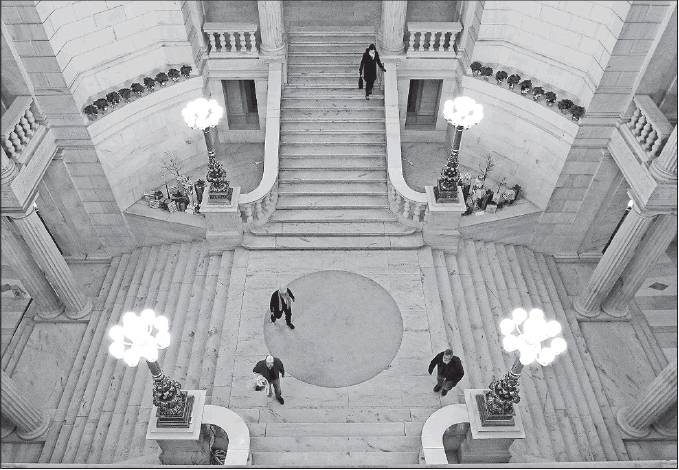A USER’S GUIDE TO R.I. GOVERNMENT
The General Assembly just started its 2020 session. Here’s how you can get involved.
By Patrick Anderson Journal Staff Writer
Rhode Island’s State House is often described as a “living museum,” and there’s no better way to get in touch with its history than by becoming a part of it through the legislative process.
When the General Assembly meets, from January to June, the opportunities to observe, demonstrate and testify on a subject of personal interest are numerous and provide a better window into the workings of government than any panel of pundits.
But know what you are getting into ahead of time.
If you want lawmakers to know where you stand on, say, gun control, be prepared to wait. Last year’s Senate Judiciary Committee hearing on firearm-related bills drew thousands to the capitol, and went through the night and into the next morning. Other hot-button cultural issues, such as abortion, also draw a large crowd.
Other hearings, on more obscure topics, are the opposite and can be over in minutes.
Assembly essentials
On most legislative days — Tuesdays through Thursdays each week — the House and the Senate meet in their respective second-floor chambers sometime between 4 and 5 p.m.
Until late spring, those sessions feature only sporadic floor debates or votes on substantive bills, with most attention focused on committee hearings. Once the House unveils its budget bill in May or June, the action heats up on the chamber floors with long nights of floor debates and votes.
Before that end-of-session flurry, most hearings take place at “The Rise,” which is when lawmakers finish making regular-session announcements, condolences and congratulations and make their way to hearing rooms. Gauging what hour The Rise will take place is tricky and depends on whether anything controversial has come up on the floor.
Hearings
Committee agendas and room numbers are posted online and outside the second-floor State House library on a large bulletin board and new touch-screen kiosk.
Hearing rooms are scattered around the building.
The House Finance Committee vets the state budget in Room 35, a frigid, brick-walled space in the basement where the air conditioning pumps year-round. The House Judiciary Committee, Oversight Committee and others meet on the first floor in Room 101.
The Senate Judiciary Committee meets in Room 313 on the third floor, but since that is the only Senate hearing room with permanent camera equipment, the Senate has been holding more meetings in the well-appointed Senate lounge (behind the chamber), with mobile video cameras wheeled in.
All House hearings are televised on Capitol TV or audio taped and posted online. The Senate records video in Room 313 and the Lounge, but doesn’t do audio, even for Finance Committee meetings.
Sign-up sheets to testify are typically outside the hearing rooms and it’s first-come, first-speak, although lawmakers and agency officials get to cut. If it’s a high-profile issue, bring snacks.
When your name is called, make sure the red button on the table-top microphone is “up” before saying anything. On a busy night, if you are going to read from prepared remarks, the committee chair may ask you to just submit them as written testimony to save time.
Held for further study
Whatever the subject, don’t expect the arguments for or against a bill to bring an immediate conclusion.
As a matter of course, when House and Senate committees hold hearings to get testimony on a bill, they don’t vote on it. In the House, this usually happens through a pre-hearing vote to hold bills “for further study” before the hearing. Legislative leaders will later decide which bills, if any, emerge at some later date for a quick vote to advance them to the floor.
But while testimony may not change the immediate outcome, that doesn’t mean it’s irrelevant. When a bill comes before the full House or Senate for a vote on passage, supporters will frequently note if there was no opposition.
Lobbying
While hot-button cultural issues will draw members of the public from far and wide, many bills will have the attention only of advocates and lobbyists.
State law defines lobbying as “acting directly or soliciting others to act for the purpose of promoting, opposing, amending, or influencing any action or inaction” by the government. In some cases, the divide between lobbyist and advocate can be blurry, with some nonprofit, community, business and industry leaders registering as lobbyists.
R.I. Secretary of State Nellie Gorbea’s website says you don’t have to worry about registering as a lobbyist if you are, among other things: attending a rally, appearing on your own behalf, a journalist, an expert witness, responding to a government inquiry or producing public-policy research.
The sights
If you’re cooling your heels in the circa-1904 McKim, Mead and White-designed State House while waiting for a hearing to start, there are plenty of things to distract you from your phone. You might even have time to take a guided tour, which starts in the spectacular three-tiered library and is now offered in Spanish.
Among the things they’ll show you:
• The 1663 Royal Charter from King Charles II granting settlers unprecedented religious freedom.
• Apollo 11 moon pebbles by the door in the library and (at the moment) the 19th Amendment ratification bill from 1920. (There’s more on the 100th anniversary of women’s suffrage in the new basement gallery.)
• Paintings, including the Gilbert Stuart portrait of George Washington in the second-floor State Room.
• The fourth-largest self-supported marble dome in the world, with murals featuring Rhode Island history.




